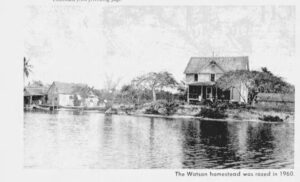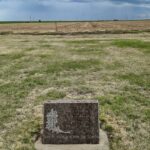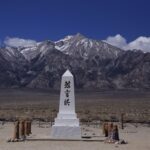Ed Watson
— Innocent, Simply Bad or Worse?
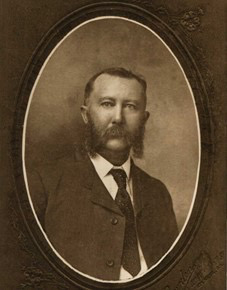 The geocache title states Ed Watson Was a Bad Man but invites the reader to decide. Perhaps that refers only to the number of times that description is modified. Was he a “very bad man” or someone worse? The difference is important. If he had gone to trial it could be the difference between life and death — although it was in Florida so probably not.
The geocache title states Ed Watson Was a Bad Man but invites the reader to decide. Perhaps that refers only to the number of times that description is modified. Was he a “very bad man” or someone worse? The difference is important. If he had gone to trial it could be the difference between life and death — although it was in Florida so probably not.
The cache description recounts how he had been linked to several murders until he reached the Everglades, where he was eventually killed. His story is intriguing.
When Ed was nine, his family moved to Florida to escape his abusive father. There are stories that he had forced the move by killing someone — there are various versions of the story but it was never more than hearsay and rumor. By then it was too late.
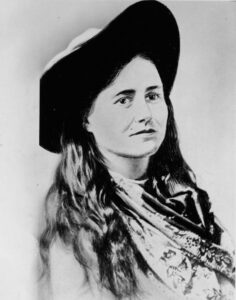 Ed was involved in a number of fights and fatally kicked his cousin in the head, after he was interrupted. Ed fled to Oklahoma. As luck would have it, he met the famous outlaw Belle Starr, who leased land to him. Belle had been close to Jesse James, Cole Younger, and numerous others. She had a reputation in her own right. Belle either spurned his advances or planned to turn him in for the Florida murder. She was ambushed on the way from a dance. Watson was tried and acquitted.
Ed was involved in a number of fights and fatally kicked his cousin in the head, after he was interrupted. Ed fled to Oklahoma. As luck would have it, he met the famous outlaw Belle Starr, who leased land to him. Belle had been close to Jesse James, Cole Younger, and numerous others. She had a reputation in her own right. Belle either spurned his advances or planned to turn him in for the Florida murder. She was ambushed on the way from a dance. Watson was tried and acquitted.
Around 1891, Watson returned to Florida. In Arcadia, he was arrested and acquitted for killing Quinn Bass. He also was acquitted after he shot someone in Columbia County. The sheriff ran him out of town.
The Everglades seemed like a good place to hide out or make a new start. He bought a claim in 1892, and land on the Chatham Bend River. He built a large house, and began farming. He was interested in harvesting sugarcane to make syrup, and obtained 90-gallon syrup kettles and a sugarcane mill to start his Island Pride business,
In 1892, he moved to the Ten Thousand Island chain in Southwest Florida where he bought a claim. The Everglades was a perfect place to hide out in plain sight. Watson also acquired land in what would later, in 1923, become Collier County.
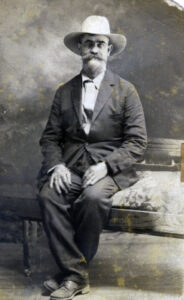 Watson sold his produce, transporting it in his 70’ schooner. On one trip to Key West, he got into an argument with local resident and slit his throat. The victim survived the attack, and Watson paid him to drop the charges.
Watson sold his produce, transporting it in his 70’ schooner. On one trip to Key West, he got into an argument with local resident and slit his throat. The victim survived the attack, and Watson paid him to drop the charges.
With his increasing wealth, he purchased and homesteaded more land in the area including acreage on Lostmans River. Watson generally hired men with no families. Rumors began to spread that he never paid his workers. When they asked for their pay, he would simply kill them, bury them in shallow graves or just dump them in one of the river tributaries. They were outsiders to the area and no one knew their names. Others say that kept his workers supplied with alcohol and tobacco. They owed him money and left quietly.
On one occasion, a young boy told a group of farmers and clam diggers that he had seen Watson kill a local woman named Hannah Smith. The boy took the men to where Hannah was buried and her body was recovered.
Everything seemed to come to a head when the Tucker family was murdered. The Tuckers were well known in thevand had grown crops on property around Lostmans River that Watson had bought. Watson told them to get off his property but they refused to leave until their crops were ready to harvest. They were all murdered and thrown in the river.
Soon after, Watson sailed his schooner to the Smallwood Store on Chokoloskee Island where he was confronted by an angry crowd. Some might have been angry because of the bodies, others because Ed had seduced many of the local women. Watson pointed his shotgun at the crowd and pulled the trigger, but it was wet and misfired. Before he could draw his revolver, the crowd opened fire and shot him numerous times. Watson kept on coming until 33 bullets were fired.
Race was always a factor. A black man, a known sharpshooter, was told to join the possee and shot Ed. The other bullets were fired so he would not be lynched.
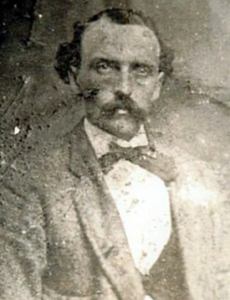 So how could he have been defended if he had stood trial? He suffered abuse as a child. He undoubtedly was victimized by having to defend against so many false charges. He helped lawyers by paying their fees. He became a scapegoat and was even run out of town by a sheriff. As the cache description notes, he was a devoted family man, paid his debts, and was generous to the neighbors that did not rile him. He had a temper, but so would you if you lived in a hot, mosquito filled swamp. He was a victim of rumor, innuendo, and jealousy. Or so the argument might have gone.
So how could he have been defended if he had stood trial? He suffered abuse as a child. He undoubtedly was victimized by having to defend against so many false charges. He helped lawyers by paying their fees. He became a scapegoat and was even run out of town by a sheriff. As the cache description notes, he was a devoted family man, paid his debts, and was generous to the neighbors that did not rile him. He had a temper, but so would you if you lived in a hot, mosquito filled swamp. He was a victim of rumor, innuendo, and jealousy. Or so the argument might have gone.
Indeed, there are some here who believe Watson was mostly innocent, or that his crimes were exaggerated. To others, Watson plainly had it coming. Nobody cared when his alleged victims were black people cutting sugar cane. His fatal mistake was to kill a white people from a well known family.
Ed lived on the cusp of change. The Everglades were being drained and development was increasing. Some suggest that a few years later Watson might have contented with selling swamps to city folk. I doubt this, however. Ed was an outlaw who would have gotten into a fight with the first person who accused him of fraud. There was a reason why his home was deep into the Everglades and the nearest town was one of the last to get roads. Perhaps hunting pythons would have calmed him down.
As soon as I learned about his story I knew we needed to visit. It was near where we planned to visit, it involved outlaws, and of course, wish a story like that, where were ghosts As Dave Latham (Ghost Hunting Florida) writes, after Watson died, the ghosts moved in.
Many people have tried to make a go of the farm, but very little ever grew there after Watson died, and everyone has been overwhelmed by the ghosts. After many years, an old woman moved into Watson’s house. She, too, encountered the phantoms, and one night, while trying to fend them off with a lighted knot torch, burned the place to the ground. Since then, snakes and vegetation have reclaimed the farm and the house.
I would add that cachers also reclaimed the area. We did not experience any ghosts, nor did we mourn for Ed, but it was an interesting place to stop.
My Log
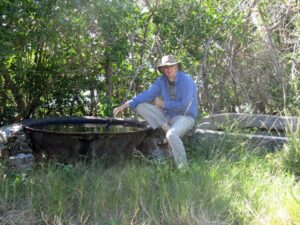
With only a short time in the area, we arranged a trip with Everglades Area Tours on Chokoloskee Island that took us from areas where shards of Calusa pottery could be seen on the beach, into the mangroves for kayaking. Eagles, osprey, heron, dolphins, and an alligator or two added to the trip.
Along the way, we stopped here, at the camp site the park service maintains. We quickly found a kettle used for the sugar cane. We had considered eating lunch here, and Jason, our guide, talked about Watson’s old Model T, still to be found a little further into the overgrowth. I would have gone there without hesitation. However, shortly after we arrived, the mosquitos discovered us here, or more importantly, discovered my wife who somehow seems to attract them (and reacts to their bites). The rest of the group was not interested in staying, So I abandoned my plans for further exploration and we did not linger here, eating on the river before heading into mangroves.
Sitting here I could imagine that people would go crazy. The endless sound of mosquitos might do it.’
Whatever the truth about Mr. Watson, he probably could have defended himself by claiming he was only trying to shoot a mosquito and missed. In any event, Watson seemed to have been the type of person where everything said about him might have been true, even if I had just made it up on the way over. And the part that is left unsaid may only be the start of the tale.
I once had neighbors that reminded me of Watson. We lived on the edge of the back country and they had been in trouble with the law. We ran into them when they were reclaiming a gun that he’d been used on a homicide, where the shooter was acquitted on self defense. The guy ran his fingers down the barrel and said that he never knew when it might be needed in the neighborhood. Periodically they stole anything they could. Eventually the Swami who lived between us and them got tired of it and bought them out. It was a better solution than the one devised by Watson’s neighbors, but then again our area did not have a body count.
Everything is different a few miles down a dirt road, or a few miles into the swamp. Bodies could disappear here. We could almost could sense a swamp monster or panther roaming. If we had stayed longer we might have seen ghosts or vampires. Or there might have been nothing to see, except for our bites.
I look forward to reading Peter Mattheissen’s book, Shadow Country, a fictional account of the crimes and the swamps, based on the reality.
(11/11/11)
